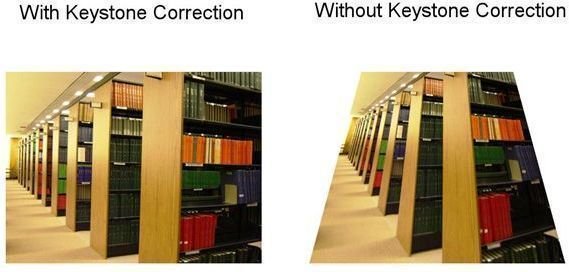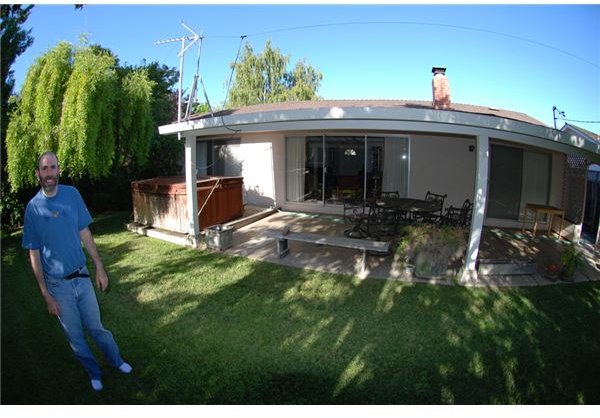Problems and Solutions in Architectural Photography
Size
One of the most obvious difficulties in photographing architecture is that buildings are often too large to fit into the viewfinder. Sometimes the solution is as simple as getting farther away, but in many situations, that’s simply not possible.
One way to help fit a building in the frame is to select a lens appropriate to the situation. If you shoot a lot of buildings or other large subjects, it’s probably worth your while to invest in a wide-angle lens. A wide-angle lens does just what its name implies: it gives your camera a wider angle of view, fitting a larger area into the image without having to more farther away. At its most extreme, a wide-angle lens becomes a fisheye lens, which fits a huge angle of view into the image, but results in considerable distortion of the subject.
Another solution to fitting a large building into your image is a panorama. Some newer digital cameras will automatically build a panorama, either from a single video pan or from a series of still images. Even if you don’t have in-camera panorama capabilities, you can still use software to create a composite image. The Photoshop plug-in Photomerge, for example, will stitch together multiple frames into a single image, provided there is enough overlap for the software to determine how to piece the frames together. You’re not limited to side-to-side sequences of images, either. You can create vertical panoramas, and even stitch together whole grids of individual frames to create one large image.
Angle, Perspective and Keystoning
Suppose you can only get your shot from an angle, instead of head-on. This can exaggerate perspective and cause horizontal elements of the building to converge (picture those old grade-school diagrams of perspective). Sometimes this will enhance the image you’re creating, depending on the effect you’re aiming for, but if you want an accurate depiction of a building, you might choose to reduce such distortion.

If you’re shooting on film with a large-format camera, you can fix many of the problems caused by awkward shooting angles by adjusting the angle and position of the back and front of the camera. A fully adjustable view camera will let you move the front (the lens plane) and back (the film plane) up and down (called “rise” and “fall”), side-to-side (called “shift”), and at angles to the head-on and vertical (called “swing” and “tilt”). Each of these has a different effect on the image and can be used to correct keystoning (where the top of an object appears smaller because it is father away) and other faults in perspective.
Very few digital cameras are built like a view camera (they do exist, but are prohibitively expensive), but some of the same functions–to a lesser degree–exist in tilt-shift lenses (also not cheap, but at least a more conceivable expense). It’s also possible to correct a lot of problems with software. Photoshop and other image-processing programs have functions that allow you to fix keystoning and other perspective issues. It’s probably a good plan to become familiar with your software by trying it out on a few images before taking hundreds of shots that might turn out to be un-correctable, but you’ll soon learn that image software can do much more than crop, rotate and color-correct.
Lighting
Due to the sheer size of most buildings, you don’t generally have much control over lighting when you are shooting architecture. If you happen on a building by chance, and won’t be able to return, then you simply have to make do with what light there is.
If you can return to a building multiple times, however, you’ll get the best results if you make several visits at different times of day and in different weather to see how the lighting changes. Not only do you need to think about how conditions and times affect such things as shadows from other buildings, but you should also consider the character of the architecture. A shiny new glass and steel structure might seem more “in character” shot in hard, bright daylight, while an old, weathered building might be more appealing in softer, more diffused light. The only way to tell is to observe the building under as many conditions as possible.
If you’re shooting digitally, you’ll have an advantage over shooting in film because you can take as many images as you like without wasting expensive film. Then you can compare the results later.
Night shooting of architecture can also create exciting images. If the building has external lighting, you can try long exposures with the existing lighting. If the building is small enough, you can even try painting light onto the building with an external flash unit.
Copyright and Trademark
Copyright and trademark law as it pertains to buildings is a somewhat confusing subject. In the United States, it has only been possible to copyright a building since 1990. While this appears to mean that you will need permission to photograph any building newer than 1990, that isn’t exactly the case. Copyright of buildings is intended to protect the design of the building so that someone else can’t build another one like it. It shouldn’t affect a photographer’s ability to photograph it. As long as the building can be viewed from a public space, you should be fine. Note, however, that this applies to the exterior of buildings. Many building interiors cannot be photographed without permission.
Trademark is another case entirely. Some buildings, even older buildings such as the Rock & Roll Hall of Fame, are trademarked, which means that their image is associated with a particular company and only that company can use the image as a representation of their company for commercial purposes. That doesn’t mean you can’t photograph such buildings, or even sell your photographs of them, but it could mean the owner of the trademark will try to prevent such sale, and might even attempt to sue. Many stock photo companies won’t purchase or sell images of trademarked buildings for this reason.
Please note: I am not a lawyer or a legal expert, simply an interested photographer, so please don’t take these comments as legal advice. If you’re in any doubt, consult a lawyer.
References
- Diskin, Daniel. " The Confusion Over Buildings as Trademarks." Copyright & Trademark Blog, March 14, 2011. Online at http://copymarkblog.com/2011/03/14/the-confusion-over-buildings-as-trademarks/
- Davis, Jack and Ben Willmore. How to Wow: Photoshop for Photography. Peachpit Press, 2004.
- Image 2 credit: Vertical keystoning. Public domain image via Wikimedia Commons.
- Russell, Elizabeth T. “Copyright and Trademark Issues for Buildings and Architectural Works.” Article and video online at http://www.artistshousemusic.org/videos/copyright+and+trademark+issues+for+buildings+and+architectural+works
- Calder, Julian and John Garrett. The 35mm Photographer’s Handbook. Pan Books, 1982.
- Upton, Barbara London, with John Upton. Photography Fourth edition. Scott, Foresman and Company, 1989.
- PhotoSecrets. “Law: Buildings Copyright and Trademarks.” Online on the PhotoSecrets website http://www.photosecrets.com/photography-law-buildings-copyright-and-trademarks
- Image 1 credit: Fisheye distortion. Public domain image via Wikimedia Commons.
- Dorrell, Peter G. Photography in Archaeology and Conservation. Second edition. Cambridge UP, 1994.
